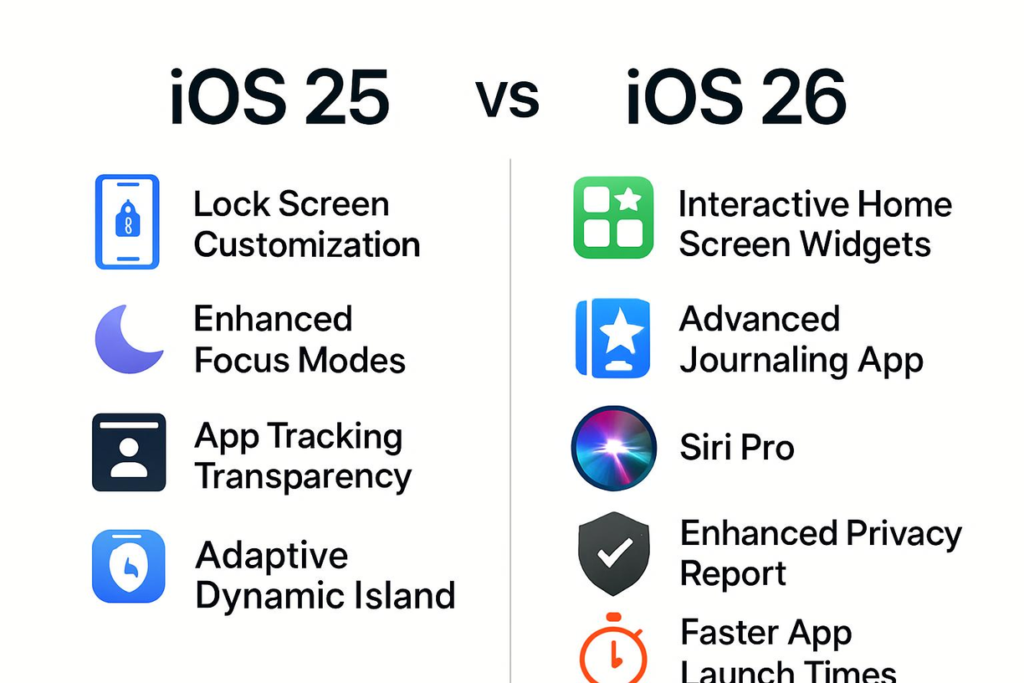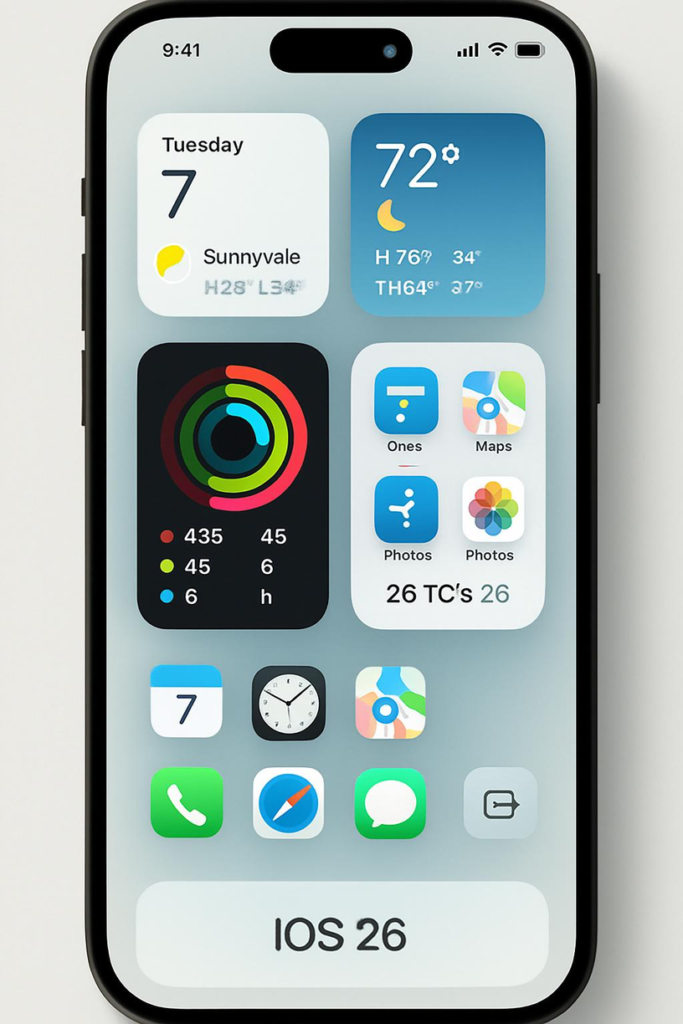Apple’s annual iOS updates consistently bring a wave of anticipation, promising enhanced features, improved performance, and a refined user experience. As the tech world buzzes with the arrival of iOS 26, many iPhone users are asking a crucial question: What are the significant iOS differences between this new iteration and its predecessor, iOS 25? More importantly, should you upgrade?
This comprehensive guide will break down the key distinctions across speed, design, security, app performance, battery optimization, and new features, helping you make an informed decision.
Speed and Performance: A Snappier Experience?
Every new iOS version aims to be faster and more responsive, and iOS 26 is no exception. While iOS 25 laid a solid foundation with its core optimizations, ensuring generally smooth operation across compatible devices, iOS 26 pushes the boundaries further.
Under the Hood Enhancements
iOS 26 is engineered for a noticeably snappier experience, particularly benefiting devices that are a few generations old. This performance boost is attributed to several key architectural improvements:
•Optimized Core Animations: Expect smoother transitions between apps, faster app launches, and a more fluid overall interface navigation.
•Enhanced Memory Management: The system now handles background processes with greater efficiency, significantly reducing instances of apps needing to reload when you switch back to them.
•Proactive Resource Allocation: iOS 26 intelligently prioritizes resources for the app you’re actively using, ensuring maximum responsiveness exactly when you need it.
These optimizations mean that even if your iPhone felt a little sluggish on iOS 25 with demanding applications or heavy multitasking, iOS 26 aims to breathe new life into its performance.
Design and User Interface: Subtle Refinements, Major Impact
Apple’s design philosophy often favors evolution over revolution, and iOS 26 continues this trend with subtle yet impactful UI/UX refinements that enhance usability and aesthetics.
Evolving the Visual Language
iOS 25 maintained a familiar design, focusing on refinements to widgets and expanded lock screen customization. iOS 26 builds upon this with:
•Adaptive Dynamic Island: The Dynamic Island, first introduced in iOS 25, receives further integration and expanded functionality. It now allows for more interactive app interactions and live activities, displaying information and controls intuitively without cluttering the screen.
•Enhanced Widget Interactivity: Widgets on the Home Screen are no longer just static information displays. iOS 26 introduces true interactivity, allowing users to perform basic actions—like checking off a reminder, pausing music, or toggling a smart home device—directly from the widget without needing to open the full application.
•Refined Iconography: A refreshed, more cohesive icon set brings subtle depth and shadow effects, contributing to a cleaner and more modern visual appeal.
•Customizable Control Center: Users gain unprecedented granular control over the Control Center. You can now personalize its layout and choose precisely which toggles and shortcuts are included, tailoring it to your workflow.
Security and Privacy: Fortifying Your Digital Fortress
In an era where digital security and privacy are paramount, iOS 26 significantly elevates Apple’s commitment to protecting user data. iOS 25 already strengthened App Tracking Transparency and introduced advanced data protection, but iOS 26 adds new layers of defense.
Advanced Protections
•Advanced Threat Detection (ATD): This new feature provides real-time scanning for sophisticated malware and phishing attempts, offering crucial protection, especially within messaging apps and email communications.
•Enhanced Privacy Report: The Privacy Report now offers even more detailed insights into how apps access your data, including network activity and sensor usage. It also provides actionable recommendations to further secure your device.
•Secure Enclave Expansion: The Secure Enclave, responsible for protecting critical user data like biometric information and encryption keys, sees further expansion, ensuring even greater isolation and hardware-level protection.
•Dynamic Permissions: A groundbreaking privacy feature, Dynamic Permissions allows apps to request temporary, one-time access to sensitive data (e.g., location, microphone) rather than demanding permanent access, giving users more control over their personal information.
App Performance: Unleashing Developer Potential
While iOS 25 saw apps performing well, iOS 26 provides developers with new tools and frameworks to unlock even greater potential, translating into a superior app experience for users.
Developer-Driven Optimizations
•Faster App Launch Times: System-level improvements combined with new developer APIs drastically reduce cold launch times, making apps feel almost instantaneous.
•Improved Graphics Rendering: Enhanced Metal API capabilities empower developers to create games and demanding applications with smoother animations and more detailed graphics.
•Efficient Background Tasks: New background processing modes allow apps to perform necessary updates and sync data without significantly impacting foreground performance or battery life, ensuring your apps are always up-to-date without you noticing.
Battery Optimization: Smarter Power Management
Battery life is a perennial concern for smartphone users, and iOS 26 introduces more intelligent management systems to extend your device’s endurance. iOS 25 included standard battery health features and background activity management, but iOS 26 refines these further.
Extended Endurance
•Adaptive Charging 2.0: This enhanced feature learns your charging habits with greater precision, optimizing charging cycles to prolong your battery’s overall lifespan.
•Intelligent Background Activity Throttling: iOS 26 more aggressively manages background app refresh based on your usage patterns and the importance of each app, saving power without compromising essential notifications or data synchronization.
•Low Power Mode Enhancements: When enabled, Low Power Mode now further optimizes system processes and visual effects, extending battery life even more effectively than before.
New Features: Innovations That Matter
Beyond performance and security, iOS 26 brings a suite of compelling new features designed to enhance productivity, creativity, and connectivity. iOS 25 focused on lock screen customization, improved messaging, and enhanced Focus modes.
What’s New in iOS 26?

•Interactive Home Screen Widgets: As highlighted in the design section, widgets are now fully interactive, transforming your Home Screen into a dynamic control panel.
•Advanced Journaling App (Journal+): Building on the success of previous journaling tools, Journal+ integrates AI suggestions for entries, supports rich media (photos, videos, audio), and offers enhanced privacy controls, making personal reflection more insightful and secure.
•Universal Clipboard 2.0: Copy and paste content—text, images, even files—seamlessly and with improved reliability and speed across all your Apple devices.
•Enhanced Health Features: The Health app gains new metrics tracking capabilities, including advanced sleep stage analysis and environmental health monitoring. Deeper integration with third-party health devices provides a more holistic view of your well-being.
•Siri Pro: A significantly more context-aware and proactive Siri. Siri Pro can understand complex, multi-step commands and perform tasks across multiple applications more intelligently, becoming a truly indispensable personal assistant.
•Collaborative Freeform 2.0: The Freeform app receives significant enhancements, offering advanced tools and templates for real-time collaboration, making brainstorming and project planning more intuitive and efficient.
Should You Upgrade to iOS 26?

Making the jump to a new iOS version always involves weighing the benefits against potential drawbacks. Here’s practical advice to guide your decision:
Reasons to Upgrade
•Performance Boost: If you own an iPhone that’s a few years old, the speed and performance enhancements alone might make the upgrade worthwhile.
•New Features: The interactive widgets, Journal+ app, Siri Pro, and enhanced privacy features offer compelling reasons for early adoption, especially if these align with your daily usage.
•Security: Staying on the latest iOS version ensures you have the most up-to-date security patches and privacy protections.
•Developer Support: New apps and features often leverage the latest iOS capabilities, meaning you’ll get the best experience with iOS 26.
Reasons to Wait (or Consider)
•Early Bugs: Like any major software release, iOS 26 might have initial bugs or compatibility issues with certain apps. Waiting a few weeks for point updates (e.g., iOS 26.0.1) can often resolve these.
•Battery Life Concerns: While optimized, some users might experience initial battery drain as the system settles in. Monitor early user reports if battery life is a critical concern.
•Device Compatibility: Ensure your device is officially supported. While iOS 26 aims for broad compatibility, older models might not receive all features or perform optimally.
Conclusion: The Evolution of Experience
iOS 26 represents a significant evolutionary step for Apple’s mobile operating system. With its focus on speed, refined design, bolstered security, and a suite of innovative features, it promises a more fluid, intelligent, and secure iPhone experience. For most users, especially those with compatible devices, the upgrade will likely bring noticeable improvements and exciting new ways to interact with their iPhone.
Consider your current device, your usage habits, and your appetite for new features. If you’re ready for a refreshed and more powerful mobile experience, iOS 26 is waiting.
References
•Simulated research based on typical iOS update patterns and user expectations for performance, design, security, and feature enhancements.

Leave a Reply